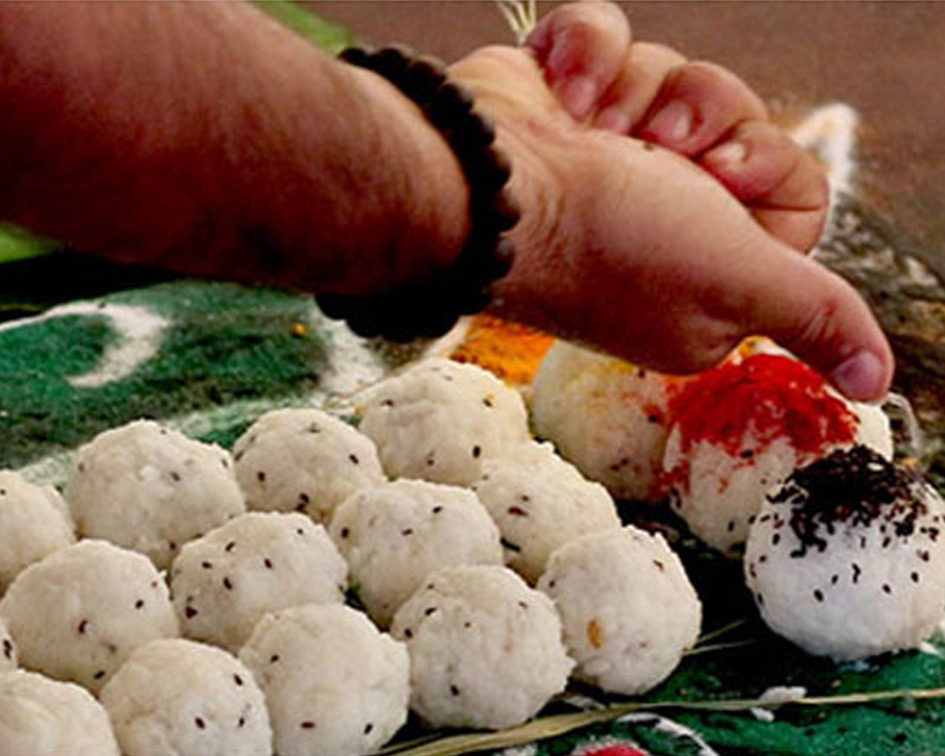Tripindi shradh
Home / Tripindi shradh
🔱 Tripindi shradh

Holy worship for Pitru Rin Mukti
In Hinduism, there are three types of debts on a human being - Dev Rin, Rishi Rin and Pitru Rin. Of these, the tradition of Shraddha is prescribed to repay Pitru Rin. Out of the various types of Shraddha, 'Tripindi Shraddha' is considered a worship ritual, the meaning and importance of Tripindi Shraddha The word 'Tripindi' is made up of two words - 'Tri' means three and 'Pind' means food, a round shaped sacred offering material. It literally means 'offering of three Pindas'.
It is dedicated to three generations - late father, grandfather and great grandfather. Each Pinda symbolizes one generation.
An attempt to free the souls of ancestors from the bondage of these three qualities - Satvik, Rajasik and Tamasik.
According to some beliefs, these pindas help the ancestors in their journey to Bhulok, Pitrulok and Devlok.
The main importance of Tripindi Shraddha is to provide salvation to those souls who have had an untimely death, who are wandering in the ghost-spirit world for some reason, or who have not found peace after death. It is believed that with this method, the souls of the ancestors are satisfied and they get liberation, and the Kundali Dosh on the family also ends.
This Shraddha is different from the normal Shraddha and it is performed only in special circumstances:
· Premature death: Those relatives who have died due to accident, suicide, murder, or any other unnatural reason.
· Pitru Dosh: When there is a serious Pitru Dosh in the astrological horoscope.
· Bad dreams: If there are frequent nightmares about the ancestors or there is a feeling of their unsatisfied soul.
· Family unrest: There is an atmosphere of continuous mishap, financial loss, disease, or unnecessary quarrel in the house.
· Obstacle in increasing the lineage: If there are persistent problems in having children.
It is performed during Pitru Paksha, especially on the day of Sarvapitre Amavasya, or on any Amavasya. The advice of a qualified Brahmin or Tantrik is mandatory for this.
Tripindi Shraddha Vidhi (in brief)
This method is very complex and detailed and should be performed only under the guidance of a learned Brahmin.
· The person performing the Shraddha (karta) should observe a fast until the puja is completed.
· After bathing, clean or white clothes should be worn.
· Three balls of black sesame, barley flour and rice flour are prepared. These are placed on a pure leaf or copper vessel.
· Each ball is dedicated in the name of a specific generation (father, grandfather, great grandfather).
· First Ganesha, then Vishnu and one's Kul Devta are invoked and worshipped.
· After this, the ancestors are invoked. The performer takes kusha in his hand and invokes the ancestors by reciting their name, gotra and the circumstances of their death.
· The three pindas are worshipped. Water, rice, flowers are offered on each pinda.
· The most important step: The three pindas are placed in order. And after performing the puja, the souls of three generations depart together towards salvation.
· The pindas are satiated by tarpan (water offering).
· Special mantras are recited for the peace and liberation of the ancestors, such as:
Om Namo Vaha Pitro Rasaaya Namo Vaha Pitrah Shoshaya. Namo Vaha Pitro Jeevaya. Swadha Namo Vaha. Swadha Namaste. Swadha Namaste.
Gaya (Bihar): It is impossible to talk about Tirtha Shradh and not mention Gaya. Gaya is called the place of salvation for ancestors. Here, performing Pind Daan on the banks of the Falgu river has special significance. It is believed that Lord Vishnu performed Yagya on the body of Gayasur here, which further increased the sanctity of this place. By performing Shraddha here, ancestors directly attain salvation.
2. Prayagraj (Uttar Pradesh): Performing Shraddha, Tarpan and Pind Daan at the confluence of Triveni Sangam - Ganga, Yamuna and invisible Saraswati is considered extremely virtuous. Performing Shraddha here during Kumbh and Magh Mela has special significance.
3. Haridwar (Uttarakhand): Haridwar, situated on the banks of the river Ganga, is also a major center for Shraddha Karma. Shraddha is performed at places like Har Ki Pauri and Ganga Ghat, Narayan Sheela Temple etc.
4. Kashi (Varanasi): Performing Shraddha of ancestors in Kashi, the city of salvation, liberates them from the bondage of life. Here performing shraddha at Manikarnika Ghat and other main ghats is considered to be especially fruitful.
5. Badrinath (Uttarakhand): Performing pind daan at Badrinath gives peace and salvation to the soul of ancestors. The shraddha and pind daan performed at Badrinath, the Tapabhoomi of Nar-Narayan, destroys the sins of many births.
Finally, the pindas are immersed in a holy river, Ganga Ji or a reservoir or fed to a cow.
📌 Puja Highlights
- Price: ₹9,500
- Salvation for Ancestors – Provides peace and liberation to souls of those who died unnaturally (accident, suicide, murder, untimely death).
- Pitru Dosh Removal – Reduces strong Pitru Dosh in horoscope and ends obstacles like financial loss, disease, and quarrels.
- Relief from Nightmares & Negativity – Pacifies wandering souls of ancestors and stops recurring bad dreams.
- Family Prosperity – Restores peace, happiness, and protects lineage growth (helps overcome child-related issues).
- Holy Pilgrimage Blessings – Performing at Gaya, Prayagraj, Kashi, Haridwar or Badrinath gives immense punya and ensures Moksha for ancestors.
